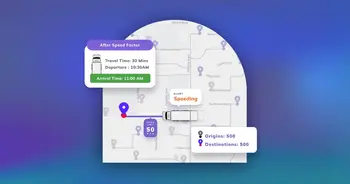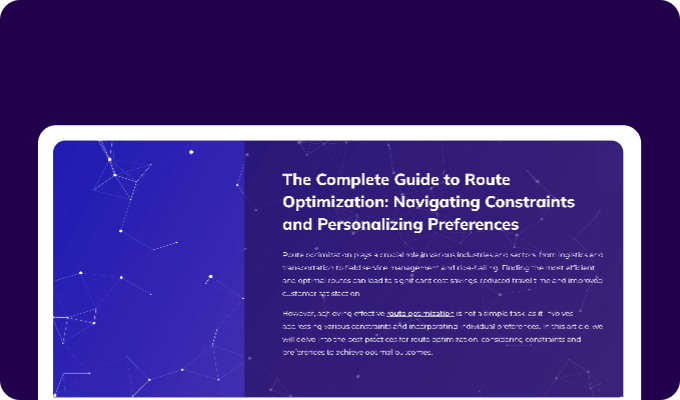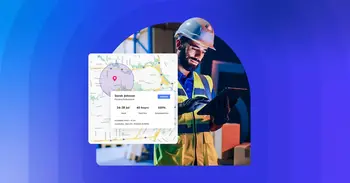Prospect #1 – A food delivery company with a fleet size of 22 vehicles (6 types of vehicles) that fulfills 250 deliveries/day on average. Their top 3 routing challenges were planning for next-day deliveries, fulfilling orders within a time window, and accounting for constraints such as weight and number of pallets.
Prospect #2 – A domestic appliance service company with 60 engineers who collectively attend at least 250 service calls per day. The issue that they were looking to resolve was optimizing routes for their engineers for different time slots. They also wanted to reduce service response times and improve resource utilization in selected geographies/areas.
Prospect #3 – A grocery delivery company with a large fleet of riders. They were looking for a routing solution that could help them escape the hefty penalties levied by city authorities for driving through low-emission zones (LEZ).
Prospect #4 – A pest control company wanted to know if it was possible to tweak the service times of some of the job requests and add similar specific constraints to the optimized routes.
The snippets of information you see above are a few of the many complex routing use cases that businesses wanted a solution for. We received these requests over the past few months while the product and engineering team were working on version 2 of our routing API.
And we are happy to announce that we’ve launched our new and improved Route Optimization API! We can now address all the complex routing needs — like the ones mentioned above — of mobility-driven businesses.
The new NextBillion.ai Route Optimization API — What’s changed?

Difference between (left) Traveling Salesman Problem (TSP) and (right) Vehicle Routing Problem (VRP)
Let’s jump straight to what’s different about the new API.
The first version of our Route Optimization API efficiently solved the Traveling Salesman Problem (TSP) for deliveries. We enabled many mobility-driven companies to reduce travel costs, distance traveled and total travel time. We did this by finding the optimal route between a set of locations, with multiple drop points for a single vehicle.
The latest version is a far more sophisticated API for route planning and optimization. Why? Because along with a TSP solver, it now comes with a built-in solver for the Vehicle Routing Problem (VRP). The API can now generate routes for multiple vehicles instead of generating routes for just a single vehicle.
It can solve an array of routing problems with multiple constraints. We’ve listed a few:
- TSP (traveling salesman problem)
- VRPTW (vehicle routing problem with time windows)
- Multi-depot heterogeneous vehicle with time windows
- Pick-up and delivery problem with time windows
Here are some of the benefits that our end-to-end Route Optimization API delivers:
- Generates accurate ETAs specific to each vehicle type
- Provides optimized and accurate routes for multiple drivers/riders/vehicles, and multiple origins and destinations
- Computes precise geocodes
- Allows adding unplanned stops into an existing delivery route, and dispatching these updated routes to drivers and delivery personnel — all through one single interface
- Creates optimized routes based on service time windows, number of deliveries/pick-ups, skills required, priority and other such parameters
- Accounts for factors such as vehicle capacity, shift hours, driver breaks and maximum number of tasks for effective order dispatch and assignment
Examples of industry-specific use cases the Route Optimization API can solve
1. Last-mile, logistics, transportation and delivery services

The businesses mentioned above require a solution to help them deliver multiple packages to multiple delivery locations within the promised delivery timeline. The API optimizes allocation, assignment and routing for deliveries, including last mile and last yard.
It creates optimized routes with accurate ETAs and routes according to the vehicle type. Besides automated order assignment and dispatch, it also solves the resource allocation issue for these businesses.
2. Service calls

The speed and performance of the service request fulfillment process heavily influence a business’ customer experience score. NextBillion.ai’s Route Optimization API helps companies to improve CX with automated and accurate task allocation, dispatch and routing for service calls.
For multiple service calls from different locations, it ensures that tasks are assigned based on the skills, shift times and location.
Not just any route optimization API, but a complete end-to-end solution

Our Route Optimization API is supported by a host of NextBillion.ai’s other APIs, tools and mapping services in the back end, which help it run like a well-oiled machine.
The end-to-end vehicle routing problem solver leverages:
Geocoding API – This API greatly improves location address accuracy and precision, even when working with unstructured addresses and incomplete location data. It can efficiently forward and reverse geocode geographic locations and coordinates. The Geocoding API also offers an error-free, intuitive auto-complete and auto-suggest search experience.
Navigation SDK – Designed specifically for business use cases, the Navigation SDK provides smooth turn-by-turn guidance through any route and topography. Users can add custom map data layers, insert custom routes and reflect real-time road restrictions — a set of features that existing mapping providers don’t offer.
Directions API – NextBillion.ai’s Directions API computes directions between locations for different transport modes, waypoints and travel times. It produces segment-wise information like distance and speed profile for a wide range of travel modes — be it bikes, cars, trucks, EVs or pedestrians. The API enables businesses to optimize their ETAs, find the best route between an origin and destination, and create accurate turn-by-turn directions.
Map Tiles API – This API helps display detailed map information in multiple styles on any web and mobile application’s user interface by merging custom map data.
Large Distance Matrix API – With the ability to support a 5000*5000 matrix size, mobility-driven businesses across the globe have been using this API to scale effortlessly. NextBillion.ai’s custom Distance Matrix API predicts accurate distances and travel times for one-to-many or many-to-many scenarios. The API can be customized to serve the needs of each business’ unique use cases.
This set of APIs and map tools enable companies to build custom maps and applications to meet their specific needs. Through custom map stacks, businesses can enable use cases that have primarily remained unserved or underserved for decades.
VRP Solver in action
Here’s a sample product demo that demonstrates how our Route optimization API with VRP solver generates optimal routes (the solver interface shown in the GIFs is for representation purposes only).
1. Set parameters for your use case

2. NextBillion.ai’s Geocoding and Map Tiles APIs at work

3. Route Optimization API at work in tandem with Distance Matrix API

4. Make adjustments to the route planning process to add extra stops

5. NextBillion.ai’s Navigation SDK at work

What you gain from NextBillion.ai Route Optimization VRP solver API
As illustrated in the snippets of customer conversations we shared in the introduction, the needs of today’s mobility-driven businesses are complex.
Our highly configurable and customizable Route Optimization API, run on top of our Distance Matrix and Directions APIs, can solve the most complex routing and assignment problems.
It can generate optimal routes for people, packages and vehicles. It can solve shifts and job assignment problems. It can enable unserved use cases for a wide range of industries — be it supply chain, logistics, on-demand delivery, e-commerce, last-mile delivery, servicing, fleet management or asset management.
Here’s what you get:
1. Optimal routes that meet all constraints
NextBillion.ai’s API has solved one of the biggest challenges businesses face, i.e., creating routes that meet the strictest constraints. Unique routing requirements, strict pick-up and delivery time windows, and mixed fleets are just a few of the many business and regulatory constraints that the solver supports.
The API can be easily customized as per your business logic. It can account for parameters like multiple drivers, heterogeneous fleets and capacity-wise load assignment to create the most optimized assignment, allocation and routing sequences.
2. A custom map stack
Work with a map stack that is tailored to your specific use cases. Plan and optimize your routes for multiple stops by leveraging private and custom map layers that are enriched with attributes like vehicle type, road conditions, driving restrictions, traffic regulations and more.
3. Accurate ETAs and routes
Improve the accuracy, reliability, precision and validity of your ETA predictions with our proprietary ETA and routing engine powered by AI, ML, fresh map data, proprietary data and historical data. Generate accurate ETAs for every use case, geography and vehicle type.
4. TSP – Reordering of stops and sequences
Experience fast and accurate reordering with NextBillion.ai’s Route Optimization API. The robust routing engine can evaluate and plan multi-stop routes in seconds, thanks to AI-powered algorithms.




